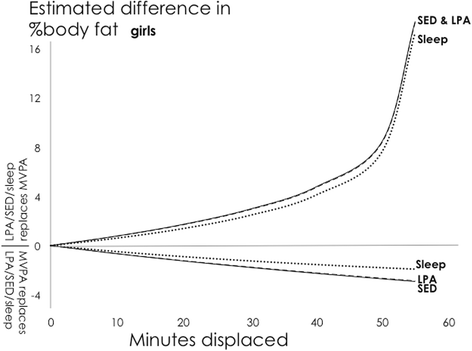Adiposity and the isotemporal substitution of physical activity, sedentary time and sleep among school-aged children: a compositional data analysis approach
- PMID: 29499689
- PMCID: PMC5834855
- DOI: 10.1186/s12889-018-5207-1
Adiposity and the isotemporal substitution of physical activity, sedentary time and sleep among school-aged children: a compositional data analysis approach
Abstract
Background: Daily activity data are by nature compositional data. Accordingly, they occupy a specific geometry with unique properties that is different to standard Euclidean geometry. This study aimed to estimate the difference in adiposity associated with isotemporal reallocation between daily activity behaviours, and to compare the findings from compositional isotemporal subsitution to those obtained from traditional isotemporal substitution.
Methods: We estimated the differences in adiposity (body fat%) associated with reallocating fixed durations of time (isotemporal substitution) between accelerometer-measured daily activity behaviours (sleep, sedentary time and light and moderate-to-vigorous physical activity (MVPA)) among 1728 children aged 9-11 years from Australia, Canada, Finland and the UK (International Study of Childhood Obesity, Lifestyle and the Environment, 2011-2013). We generated estimates from compositional isotemporal substitution models and traditional non-compositional isotemporal substitution models.
Results: Both compositional and traditional models estimated a positive (unfavourable) difference in body fat% when time was reallocated from MVPA to any other behaviour. Unlike traditional models, compositional models found the differences in estimated adiposity (1) were not necessarily symmetrical when an activity was being displaced, or displacing another (2) were not linearly related to the durations of time reallocated, and (3) varied depending on the starting composition.
Conclusion: The compositional isotemporal model caters for the constrained and therefore relative nature of activity behaviour data and enables all daily behaviours to be included in a single statistical model. The traditional model treats data as real variables, thus the constrained nature of time is not accounted for, nor reflected in the findings. Findings from compositional isotemporal substitution support the importance of MVPA to children's health, and suggest that while interventions to increase MVPA may be of benefit, attention should be directed towards strategies to avoid decline in MVPA levels, particularly among already inactive children. Future applications of the compositional model can extend from pair-wise reallocations to other configurations of time-reallocation, for example, increasing MVPA at the expense of multiple other behaviours.
Keywords: Physical activity; adiposity; isotemporal substitution; sedentary behaviour; sleep.
Conflict of interest statement
Ethics approval and consent to participate
The Pennington Biomedical Research Center in Baton Rouge, Louisiana coordinated ISCOLE and received ethical approval for the overall study protocol from their Institutional Review Board. The four sites also received approval from local ethics committees and school boards. Parents provided signed informed consent and child assent was attained prior to inclusion in the study.
Consent for publication
Not applicable
Competing interests
The authors declare that they have no competing interests
Publisher’s Note
Springer Nature remains neutral with regard to jurisdictional claims in published maps and institutional affiliations.
Figures






References
-
- Poitras VJ, Gray CE, Borghese MM, Carson V, Chaput J-P, Janssen I, et al. Systematic review of the relationships between objectively measured physical activity and health indicators in school-aged children and youth 1. Appl Physiol Nutr Metab. 2016;41(6):S197–S239. doi: 10.1139/apnm-2015-0663. - DOI - PubMed
-
- Gupta N, Heiden M, Aadahl M, Korshøj M, Jørgensen MB, Holtermann A. What Is the Effect on Obesity Indicators from Replacing Prolonged Sedentary Time with Brief Sedentary Bouts, Standing and Different Types of Physical Activity during Working Days? A Cross-Sectional Accelerometer-Based Study among Blue-Collar Workers. PLoS One. 2016;11(5):e0154935. doi: 10.1371/journal.pone.0154935. - DOI - PMC - PubMed
Publication types
MeSH terms
Grants and funding
LinkOut - more resources
Full Text Sources
Other Literature Sources
Medical

